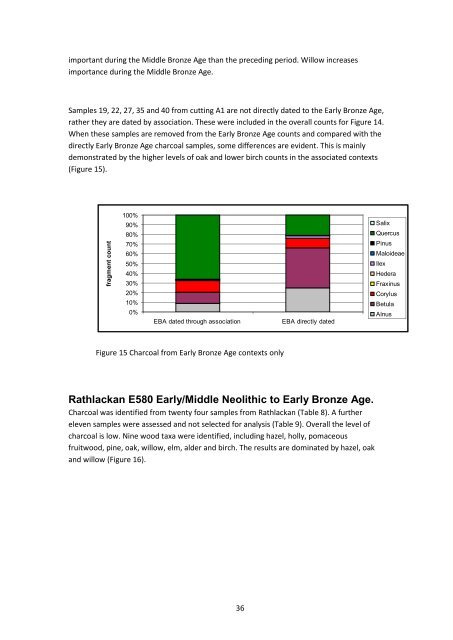Neolithic and Bronze Age Landscapes of North Mayo: Report 2011
Neolithic and Bronze Age Landscapes of North Mayo: Report 2011
Neolithic and Bronze Age Landscapes of North Mayo: Report 2011
You also want an ePaper? Increase the reach of your titles
YUMPU automatically turns print PDFs into web optimized ePapers that Google loves.
important during the Middle <strong>Bronze</strong> <strong>Age</strong> than the preceding period. Willow increases<br />
importance during the Middle <strong>Bronze</strong> <strong>Age</strong>.<br />
Samples 19, 22, 27, 35 <strong>and</strong> 40 from cutting A1 are not directly dated to the Early <strong>Bronze</strong> <strong>Age</strong>,<br />
rather they are dated by association. These were included in the overall counts for Figure 14.<br />
When these samples are removed from the Early <strong>Bronze</strong> <strong>Age</strong> counts <strong>and</strong> compared with the<br />
directly Early <strong>Bronze</strong> <strong>Age</strong> charcoal samples, some differences are evident. This is mainly<br />
demonstrated by the higher levels <strong>of</strong> oak <strong>and</strong> lower birch counts in the associated contexts<br />
(Figure 15).<br />
fragment count<br />
100%<br />
90%<br />
80%<br />
70%<br />
60%<br />
50%<br />
40%<br />
30%<br />
20%<br />
10%<br />
0%<br />
EBA dated through association<br />
EBA directly dated<br />
Salix<br />
Quercus<br />
Pinus<br />
Maloideae<br />
Ilex<br />
Hedera<br />
Fraxinus<br />
Corylus<br />
Betula<br />
Alnus<br />
Figure 15 Charcoal from Early <strong>Bronze</strong> <strong>Age</strong> contexts only<br />
Rathlackan E580 Early/Middle <strong>Neolithic</strong> to Early <strong>Bronze</strong> <strong>Age</strong>.<br />
Charcoal was identified from twenty four samples from Rathlackan (Table 8). A further<br />
eleven samples were assessed <strong>and</strong> not selected for analysis (Table 9). Overall the level <strong>of</strong><br />
charcoal is low. Nine wood taxa were identified, including hazel, holly, pomaceous<br />
fruitwood, pine, oak, willow, elm, alder <strong>and</strong> birch. The results are dominated by hazel, oak<br />
<strong>and</strong> willow (Figure 16).<br />
36

















